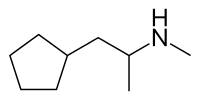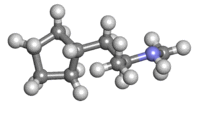 | |
 | |
| Clinical data | |
|---|---|
| Other names | N,α-dimethyl-cyclopenaneethylamine |
| Routes of administration | Topical (nasal spray) |
| ATC code | |
| Legal status | |
| Legal status |
|
| Identifiers | |
IUPAC name
| |
| CAS Number | |
| PubChem CID | |
| DrugBank | |
| ChemSpider | |
| UNII | |
| KEGG | |
| ChEMBL | |
| Chemical and physical data | |
| Formula | C9H19N |
| Molar mass | 141.254 g·mol−1 |
| 3D model (JSmol) | |
| Chirality | Racemic mixture |
| Boiling point | 171 °C (340 °F) |
SMILES
| |
| |
| (verify) | |
Cyclopentamine (trade names Clopane, Cyclonarol, Cyclosal, Cyklosan, Nazett, Sinos, among others) is a sympathomimetic alkylamine, classified as a vasoconstrictor. Cyclopentamine was indicated in the past as an over-the-counter (OTC) medication for use as a nasal decongestant, notably in Europe and Australia, but has now been largely discontinued possibly due to the availability, effectiveness, and safety of a structurally similar drug, propylhexedrine.
Pharmacology
Cyclopentamine acts as a releasing agent of the catecholamine neurotransmitters norepinephrine (noradrenaline), epinephrine (adrenaline), and dopamine.[1] Its effects on norepinephrine and epinephrine mediate its decongestant effects, while its effects on all three neurotransmitters are responsible for its stimulant properties. When ingested orally in sufficient quantities, cyclopentamine produces similar effects to amphetamine, methamphetamine, and propylhexedrine.[2][3]
Chemistry
Cyclopentamine is the cyclopentane homolog of propylhexedrine, differing only in terms of the contracted ring size of a cyclopentane, containing one —CH2— unit less than the cyclohexyl group.
In terms of the acyclic part of the molecule, both cyclopentamine and propylhexedrine are the same as methamphetamine, all three molecules containing the 2-methylaminopropyl side-chain. The difference between them is that whereas methamphetamine is an aromatic molecule containing a phenyl group, cyclopentamine and propylhexedrine are entirely aliphatic and contain no delocalized electrons at all. The effect that this has on potency is that the reduced alicyclic-alkylamines are weaker than unsaturated (meth)amphetamine.
See also
- Amphetamine
- Cypenamine (which is trans-2-phenylcyclopentylamine)
- Methamphetamine
- Propylhexedrine (also known as cyclohexamine)
- Tranylcypromine (which is trans-2-phenylcyclopropylamine)
- Methiopropamine
References
- ^ Schmidt JL, Fleming WW (July 1964). "A Nonsympathomimetic Effect of Cyclopentamine and Beta-Mercaptoethylamine in the Rabbit Ileum". The Journal of Pharmacology and Experimental Therapeutics. 145: 83–6. PMID 14209515.
- ^ Ghouri MS, Haley TJ (July 1969). "In vitro evaluation of a series of sympathomimetic amines and the beta-adrenergic blocking properties of cyclopentamine". Journal of Pharmaceutical Sciences. 58 (7): 882–4. doi:10.1002/jps.2600580722. PMID 4390216.
- ^ Marley E, Stephenson JD (August 1971). "Actions of dexamphetamine and amphetamine-like amines in chickens with brain transections". British Journal of Pharmacology. 42 (4): 522–42. doi:10.1111/j.1476-5381.1971.tb07138.x. PMC 1665761. PMID 5116035.